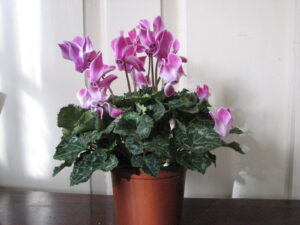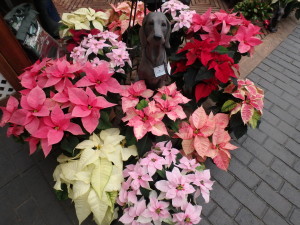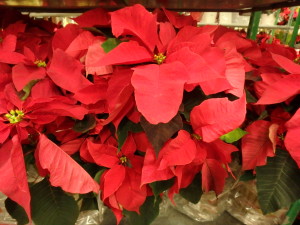Brightening the Dark Days of Winter
Posted on Tuesday, November 30, 2021 · Leave a Comment
This is the darkest time of the year: not only are the days short, clouds obscure the sun much of the time. Many of us find the gloom oppressive, especially when there is neither enough snow to ski, nor ice to skate on. And for gardeners, there is little we can (or wish to) do outside. So what do I do?
First, I go to my local grocery store or florist and buy cut flowers or potted plants. For $10 or $15 I can brighten my outlook considerably. The most economical to buy are potted plants. They will, with a minimum of care and forethought, bloom for weeks – or even for months. Here are a few of my favorites:
Christmas cactus. It should be called a Thanksgiving cactus, really, because they usually bloom well before Christmas. Buy one in full bloom, or that has a mix of blossoms and buds. They need moderate light indoors, but not hot afternoon sun. Temperatures of 60 to 70 degrees are best for success. They should not be allowed to dry out completely, but neither do they want to be kept soggy. They like humidity, so place them in a saucer of small stones and add water. Never let the pot sit in water.
Cyclamen. Another low-light plant. This one suited for even less light than Christmas cactus. If you give it any direct sunshine, an hour or two of morning sun is plenty, but indirect light is better.

Cyclamen really are not fussy, and bloom for weeks
Water your cyclamen only when dry, which depends on the temperature and relative humidity. I find picking up the pot tells me a lot: if dry, it weighs very little, when moist, it is heavier. If you go too long, the flowers will flop as if to say, “Look at me, I’m dying of thirst!” But they recover quickly. Place your plant in a saucer of water and let it suck up water. But don’t let it sit in water for long.
My mother loved African violets, and did well with them. I remember doing an experiment with my new Chemistry Set for Young Scientists when I was in the fourth grade. I made a solution of tannic acid, and put a drop on a leaf. Overnight, it burned a perfect hole! Great experiment until my mother asked me if I had done something to her plant.
I have not had great luck with African violets here in New Hampshire (they may have heard about my experiment, way back when). I largely heat with a wood stove, and keep the house warm, but quite cool at night. I finally read an article that said one should never let the temperature in the room they are in drop below 70 degrees. So I no longer try, though I have recently read that temps down to 60 degrees are okay.
If you want to grow them, keep them consistently warm in a bright room but not in direct sunshine. They like high humidity (hence do not like woodstoves) but do not tolerate soggy roots. Water from the bottom, but water once a month from above (to flush out any fertilizer salts). Never let water get on the leaves. Pinch off spent blossoms or yellowed leaves.
My absolute favorite house plant is an orchid called Phalaenopsis or moth orchid. Buy them in bloom, and they will bloom for many weeks. Direct sunlight can scorch the leaves, but they need a bright room. These are tropical orchids so like warm temperatures. But cool nights are good – down to 55 degrees.
Moth orchids in their native environment grow in trees. So the soil mix they come in is generally a special orchid mix made of bark chips, and perhaps a little perlite or vermiculite. This mix allows water to run right through it. Be sure that if it comes with an inner pot and an outer pot, to pour out water after watering from the outer pot, which normally has no drainage. Or just lift the inner pot and run water through in your sink. Otherwise you will kill your orchid. Water once a week, or if exposed roots turn silvery white.
According to the experts, tree orchids such as these do best with good air circulation. Me? I find that in a room with people coming and going there is enough air movement to keep them healthy. I do grow them over a saucer of pebbles and water to increase humidity, and grow them in the bathroom where steam from the shower helps.
But if you have no patience with house plants, or believe you cannot grow them, buy flowers for a vase. Most cut flowers will last a week in a vase, many will last longer. Most stems cost between $1.50 and $3.00. Buy an odd number of stems – 3, 5, 7 or 11, depending on your budget.
The vase for displaying cut flowers should be about half as tall as the stems are long (or a little less). But that rule is not firm. If the arrangement looks good to your eye, it is fine. Use a clean glass or pottery vase for best results, but if you want to use Grandma’s silver vase, go ahead. Elegance is good.
Cut flowers generally come with a little packet of white powder. Use it. It helps to keep the water from getting full of bacteria or fungus that will clog the stem, keeping it from taking up water. Pull off any leaves that would otherwise go in the water. You can also use a teaspoon of Clorox in a quart of water. Never put cut flowers near a radiator or wood stove.
So buy something in bloom. It will help to dissipate the gloom of short, dark days. Oh, and about that African violet: I confessed, and did not get punished. But I never experimented with her houseplants again.
Henry’s book “
Organic Gardening (not just) in the Northeast” is available from him for $19. Mail a check to Henry Homeyer at PO Box 364, Cornish Flat, NH 03746, or order from his website,
www.Gardening-Guy.com.
Indoor Plants for the Holidays
Posted on Tuesday, December 13, 2016 · Leave a Comment
Florists, garden centers and grocery stores are loaded with color right now – plants that are bright, cheery, and hard to kill. They are just what we need in these dark, dreary days of early winter when the sun goes down before 5pm. Christmas cactus and poinsettias are great plants that are affordable and easy. I recommend them highly.

Poinsettias Come in Many Colors
You may think that poinsettias have big red flowers atop handsome green foliage. Wrong! The colorful parts (they now come in white, pink, plum, burgundy, cinnamon and lemon) are actually bracts, or modified leaves. The flowers are actually just pea-sized yellow blossoms in the middle of the bracts.
Poinsettias were introduced here in 1828 by President Andrew Jackson’s ambassador to Mexico, but only became popular holiday flowers in the 1960’s. A grower in California promoted them heavily on TV, giving plants to the likes of Johnny Carson who kept them on his desk during the Tonight Show.
If you buy a poinsettia, start it off right: be sure it is enclosed in a sleeve or a bag on the way home – they hate the cold. But don’t place it near a wood stove or radiator, either. The ideal temperature is 68 to 72 degrees, but my house is rarely that warm, and they do fine with daytime temps in the sixties and night-time temps a little cooler. Anything below 50 degrees is fatal – but we wouldn’t be happy then, either.

Poinsettia Flowers are Just the Center of These Colorful Cracts
Poinsettias do not require direct sunshine. In fact, bright indirect light is best; six hours is all that is required. And don’t over-water them. Root rot results from keeping roots constantly soggy. Water once a week but check the soil first by probing the top inch with your finger. If it feels moist, you can wait. Experts say it is best to water by placing the pot in a saucer or water and letting it soak up for 15 minutes, but I never do that. I water from the top and it works just fine. I often judge dryness by the weight of the pot, too. The heavier it is, the more water is in the pot. Fertilization is not recommended when they are in their bloom cycle.
Although I don’t usually do it, you can keep your poinsettia over the summer and hope to get it to produce colorful bracts next winter. These plants are photoperiodic, which means they are sensitive to daylight length. They need 14 hours of darkness each night in the fall if they are to “bloom”. Even electric lights on in their room can interfere with the coloring-up process, I’ve read.
Christmas cactus often bloom for Christmas, though if you keep them for years they may bloom at other times. Buy one now, and you’re pretty much guaranteed blossoms through the holidays. Properly cared for, a Christmas cactus can be handed down to your kids … and later, their kids.
Like poinsettias, a Christmas cactus needs bright, indirect light and moderate temperatures. Over-watering can be lethal, so if you are starting a new plant from a cutting, add some sand to the potting mix for increased drainage. One part sand to three parts potting mix is about right.

Christmas Cactus
Christmas cacti are not true cacti – they wouldn’t survive in a desert – so you shouldn’t let them get too dry, either. Feel the soil weekly – when the soil is dry an inch below the surface, it’s time to water. If you water too much or too little you will notice flower buds falling off.
A Christmas cactus does best with humidity in the 50 to 60% range. If you have a wood stove, chances are your house is drier than that in the winter. You can remedy the situation by filling a wide saucer with small stones, add water, and placing the potted plant on the stones. As the water evaporates, it adds humidity to the air around the plant.
Aside from these colorful plants, I like to add some greenery around the house in winter. I have a number of foliage plants, but also like to pick some pachysandra outdoors to keep in vases, or to fill out bouquets of flowers I buy.
Pachysandra is a shade-loving vine with year-round glossy leaves. Even with snow on the ground you can pick stems and place them in a vase of water, where they will thrive all winter. The leaves stay glossy and green and will develop good roots in a vase. In the spring I plant them outdoors in shady places as a ground cover. Right now I have a vase full of pachysandra stems with a few twigs of red winterberries, which is quite festive.
Despite my careful attention to my outdoor plants – both vegetables and flowers – I have never paid near as much attention to indoor plants. Perhaps I need a break in winter, when they are needing my care the most. So it is important to me that house plants be relatively undemanding. Poinsettias and Christmas cactus fill the bill.
Read Henry’s twice-weekly blog at https://dailyuv.com/gardeningguy. You can sign up for an e-mail link to the blog every time he posts. His e-mail is henry.homeyer@comcast.net.






